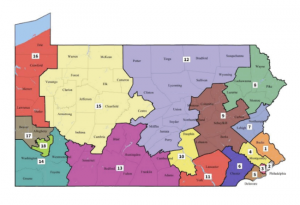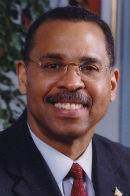 Democrats believe in democracy. As long as elections return Democratic majorities.
Democrats believe in democracy. As long as elections return Democratic majorities.
Today the Democratic Party is going to court to avoid losing legislative districts. If only purely objective, independent judges draw the lines, all will be well.
The Democrats’ concern for fairness is oddly convenient. While they controlled the government, they were happy to leave redistricting to state legislators. But over the last quarter century Republicans have done most of the winning and today control two-thirds of state legislative bodies. Now Democrats oppose letting the people’s elected representatives set election rules.
Every ten years election lines must be adjusted to reflect population shifts. The latest big court fight is in Pennsylvania, where the State Supreme Court tossed out the map approved by the Republican legislature and governor in 2011. The judges imposed their own plan, which is likely to shift several congressional seats to the Democrats.
Legislators always have sought to create districts to their advantage in a process called gerrymandering. The term came from Massachusetts Gov. Elbridge Gerry’s approval in 1812 of a legislative district that looked like a salamander.
Is this time-honored practice fair? No. But then, politics is not fair. Nevertheless, politicians remain accountable to voters. Ultimately, legislators can slow but not stop long-term population and social trends.
Moreover, there is no single “right” legislative map. Many principles apply to districting, some of which conflict. Districts should be compact, continuous, and contiguous. Districts should respect traditional political boundaries and local communities. Districts should protect the ability of minority voters to elect representatives. At the same time, legislators try to protect incumbents and maximize partisan advantage, but still are able to weigh competing interests and find compromise solutions.
The Constitution places election responsibility on state governments. Even the Supreme Court insisted that “legislative reapportionment is primarily a matter for legislative consideration and determination.” Justices recognized the dangers of being pulled into such a political issue. In 2004, four of them complained that the litigation had left “one long record of puzzlement and consternation.”
Last fall the Supreme Court took a case in which the Republican-dominated Wisconsin legislature had created districts that seemed to meet most objective criteria while delivering more seats to Republicans than their share of the vote. The plaintiffs cited an “efficiency gap,” that is, that Democratic votes were being “wasted.” In this view, the Constitution requires partisan parity even if achieving that requires creating old-style “salamander” districts.
Chief Justice John Roberts worried that this argument was “sociological gobbledygook.” The Founders chose not to use proportional representation; registered voters often split tickets and vote for candidates of other parties. Moreover, people are less likely to cast ballots in uncompetitive races, holding down the majority party’s overall vote. Compact and contiguous districts are considered desirable yet often are “inefficient.” No wonder the Constitution says nothing about how districts should be drawn.
A number of states now rely on bipartisan commissions instead of courts, but the former suffer from similar problems. Few people are truly objective and politicians try to ensure the friendliest “nonpartisan” members possible. Politics simply goes underground. Partisan results escape serious review.
The Pennsylvania case showcases the problem of politicizing the courts. No doubt, legislative Republicans took advantage of their opportunity. But the concentration of Democratic voters in cities meant some electoral imbalance was inevitable.
Moreover, the state supreme court is not above politics. To the contrary, the judges did not demonstrate the objectivity and nonpartisanship they demand in redistricting. Instead, they are political partisans who run in party primaries before making the general election ballot, where they stand as Republicans or Democrats. The Democrats hold a 5-2 majority on the state high court and undoubtedly were aware of the partisan ramifications of their decision.
The court issued its order without a majority opinion. The judges imposed tight deadlines, almost impossible for the legislature to meet. Which allowed the court to impose its own plan, which it claimed was “superior” to any of the others submitted.
However, the American Civil Rights Union (ACRU) submitted a map to the court, which by all accounts really is superior to all other submitted maps because it used only the court-ordered traditional criteria. No voter registration or any other political data was used at any time in the creation of their map. In addition, the map was drawn using mathematically determined apportionment for representative districts that keeps whole as many municipalities, townships, and counties as possible.
The fact is, redistricting is inherently political. The process will never be fair.
But leaving redistricting to legislators ensures transparency; partisanship can be reviewed. The next time an election loser runs to court, the judge or judges should reaffirm that voters are the ultimate authority in American democracy.
Photo credit: Pennsylvania Supreme Court
 Ken Blackwell is a member of the Policy Board of the American Civil Rights Union. He was Chairman of the Congressionally appointed, United States Census Monitoring Board, 1999-2001.
Ken Blackwell is a member of the Policy Board of the American Civil Rights Union. He was Chairman of the Congressionally appointed, United States Census Monitoring Board, 1999-2001.
 CURE News and Clergy Blog News and Commentary for Christians
CURE News and Clergy Blog News and Commentary for Christians




There should be a legitimate computer program utilized to create honest voting districts, eliminating gerrymandering by all political parties.
There is no Democracy in the U. S. C.
I live in a Constitutional, Republic. Three Branches.
There is No Form of govt. that is a Democracy: there is one that is Socialism.
Theocracy💡
Republic 😊
Socialism😷
Communism💀